A wonderful initiative
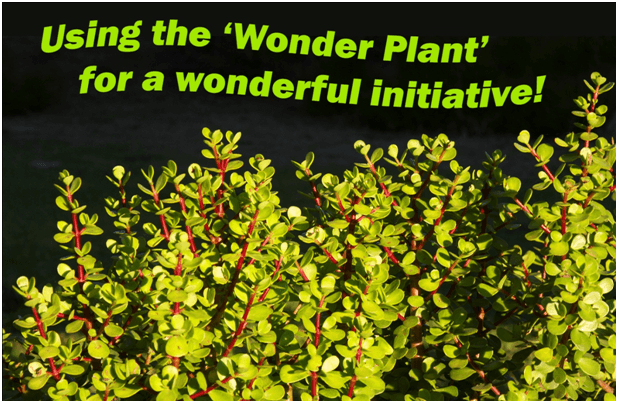
Portulacaria afra is an evergreen, succulent shrub, native to South Africa. Locally it is known as ‘Spekboom’ literally meaning ‘bacon or fat tree’ in Afrikaans but contrary to this name, the plant’s juicy round leaves have a distinct lemony flavour. It is also sometimes referred to as ‘Porkbush’ (derived from the Afrikaans name) or ‘Elephant Bush’ as it forms a staple for the elephant occurring in the thickets of the Eastern Cape province of South Africa.
The small, emerald green leaves and maroon stems make this an attractive plant particularly when in bloom. Lilac flowers which are borne in dense clusters are an important source of nectar for insects which in-turn attract a large variety insectivorous birds. Spekboom is popular with bonsai enthusiasts.
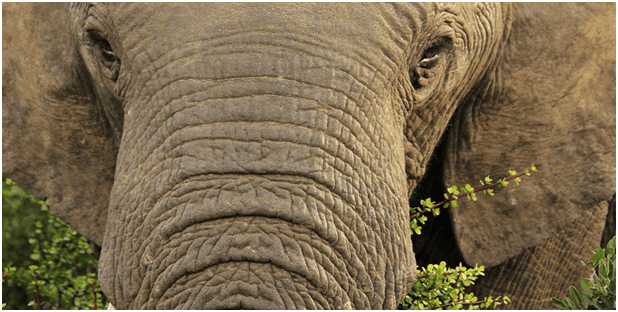
An elephant in the Eastern Cape Province feeding om Spekboom Image courtesy of Shamwari Game Reserve
So what makes Spekboom so special?
Recent research has shown the Spekboom to be an exceptional 'carbon sponge' as it has the ability to sequestrate (absorb) more free carbon from the atmosphere than most other plant species. (Carbon Dioxide - CO2 is produced in excess through the burning of fossil fuels making it one of the major greenhouse gases responsible for global warming and climate change).
Technically Spekboom can do this because it makes use of two different photosynthetic pathways: Like 85% of other plants Spekboom are physiologically active by day, collecting CO2 through tiny pores called stomata in their leaves in a process known as C3 photosynthesis. In this way plants collect CO2 which they use to fuel growth and the other essential plant processes. The indispensable by-product of this process is oxygen.
However, during dry or unfavourable conditions, the Spekboom can switch to a different type of photosynthesis pathway called CAM (Crassulacean Acid Metabolism). This is when the plant closes the pores in its leaves and branches during the day to prevent unnecessary transpiration (water loss). Yet it remains able to photosynthesise. This is made possible by acid that builds up in the leaves during the night (stored as carbon dioxide) and is broken down during the day. In this way Spekboom efficiently captures large amounts of carbon using very little water.
Botanists have established that within thicket vegetation of the Eastern Cape, Spekboom was able to absorb around 8.6 tonnes of carbon dioxide from the air per hectare per year. According to the South African National Biodiversity Institute (SANBI) a stand of Spekboom has the ability to remove far more carbon from the atmosphere than an equal amount of deciduous forest.
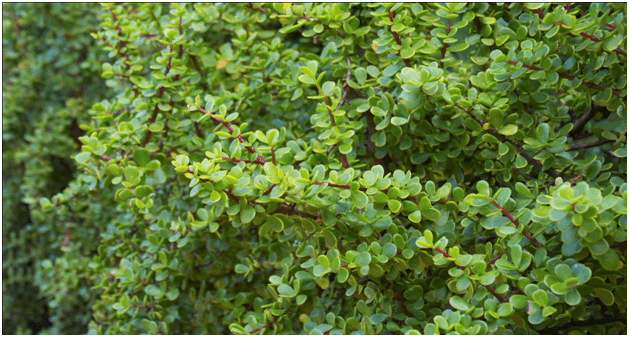
Dense stands of Spekboom offer shelter and nourishment to a variety of animals and the plants themselves can grow up to 3.5 metres in height.
Other amazing facts about Spekboom:
- Spekboom leaves are edible and have a pleasant citrus flavour. They are rich in Vitamin C and contain trace elements such as manganese, cobalt and magnesium. The leaves also hold micro elements, iodine and selenium which act as effective antioxidants.
- The plant has many traditional medicinal uses; the San people used the leaves to quench thirst on long walks and sucking a leaf was used to instantly relieve exhaustion, dehydration and heat stroke. The pulp of crushed Spekboom leaves can relieve and even cure skin ‘conditions’ ranging from blisters and insect bites to acne and sunburn. High blood sugar levels are apparently effectively treated by chewing the leaves as are sore throats and mouth infections.
- The fibrous roots of Spekboom are an effective soil binder and the plant is often used to prevent soil erosion and to restore trampled and overgrazed terrain, particularly in the arid Karoo region of South Africa.
- The Spekboom is able to reproduce vegetatively. In their natural habitat, the branches and twigs that are broken off (and fall to the ground) by animals feeding on the plant are able to take root after a few weeks. This self-propagating adaptation makes this plant ideal for mass cultivation using cuttings.
School greening initiative in the Limpopo Province.
As part of an ‘Arbour Day’ programme back in 1997 close to 100 Wild Plum Harpephyllum caffrum trees were distributed to rural schools around the city of Polokwane in the Limpopo Province as part of a greening programme. Both teachers and pupils readily embraced this initiative, to the extent that today those same trees provide enough shade for an entire class to enjoy outdoor lessons when classrooms become too hot in the summer months. This encouraging outcome is one of the motivating reasons for the current school greening initiative.
Most rural schools in the Limpopo Province are situated within impoverished communities, predominantly in the arid regions of the province. The natural habitats in most of these areas have been severely transformed as a result of deforestation (for firewood) and overgrazing (by livestock). The schoolyards themselves are barren, dusty and featureless places containing little to no vegetation. The school grounds are often enclosed by a wire mesh security fence making them even more of a discouraging place for children.

Most of the schools in the outlying rural communities of the Limpopo Province are featureless with little to no vegetation on the school premises.
So, during the first week of the imposed Covid-19 lockdown in South Africa while Joe Grosel of Tembele Ecological Services was pruning a Spekboom hedge at his farmstead in central Limpopo Province an inspired idea came to him. Why not start up a small Spekboom nursery with the idea of supplying plants to rural schools as a greening initiative which will also create a number of additional benefits! So within a few weeks a thriving nursery had been established with over 4000 Spekboom cuttings planted directly into the soil and a further 2000 in planting bags.

Joe Grosel in a portion of the newly-established Portulacaria afra, Spekboom nursery.
Why Spekboom is ideal for this purpose!
- Spekboom is a ‘water-wise’ plant that is perfect for areas with low rainfall or schoolyards that lack a good water supply or even a water reticulation system. This low-maintenance plant is drought-resistant and can survive on just 250-350mm of water a year! So, a bucket of water twice a month during the dry season will keep it healthy and happy.
- The Spekboom’s effective soil binding root system can play a vital role in curbing soil erosion in rural school grounds which are often devoid of grass cover and prone to sheet, splash and gully erosion.
- The fast-growing ‘Spekboom’ can easily be shaped into an effective hedge of up to 2m tall. This can offer privacy, hide unsightly security fences and can screen schoolyards from wind, dust and litter.
- The nutritional value of Spekboom can be sustainably utilised in rural schools by providing pupils with important vitamin and trace element supplements. These elements that help boost immune systems are often lacking in the diets of disadvantaged families in rural communities.
- The medicinal properties of the Spekboom mean that having a few of these plants growing in a school ground can help well-informed teachers in the superficial treatment of pupils with skin conditions and other minor ailments for which this plant is known to be helpful.
- Spekboom is easily propagated from cuttings and responds well to pruning so after a year or two there should theoretically be enough ‘mother plant stock’ in the school grounds to roll out thousands of new plants which scholars can even plant in their own gardens at home.
- The highly effective carbon absorption and oxygen producing abilities of Spekboom should to some extent assist in improving air quality and the micro-climate within school grounds and around classrooms, provided a large-enough grove is established.
- It is well known that that living near green spaces or having green vegetation within work or study zones can improve mood and cognition, reduce stress, encourage physical activity, reduce aggression and enhance the overall well-being in people of all ages under many different circumstances.
- A small grove of Spekboom in a school yard is like having a live biology lab that science teachers can effectively utilise in demonstrating natural processes such as photosynthesis, energy flow, pollination, symbiotic relationships etc. Learners can also be taught about current environmental challenges such as greenhouse gas emissions resulting in global warming and how plants such as the Spekboom can assist in mitigating these problems.
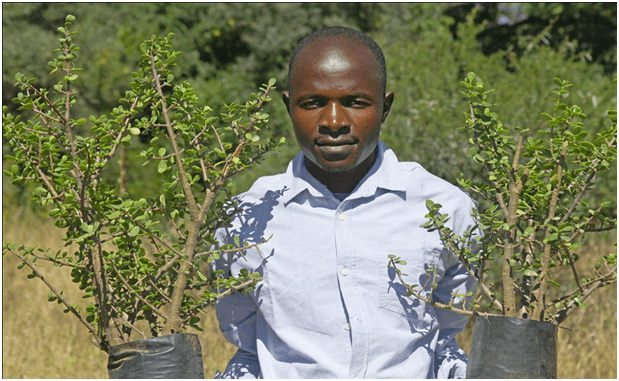
A few plants have already been handed over to teachers and headmasters at some of the schools around Polokwane that were recently visited.
Carbon Footprint offset through planting of Portulacaria shrubs and our role in greening the world.
Our ‘Carbon footprint’ is the amount of greenhouse gases—including carbon dioxide, methane, nitrous oxide, fluorinated gases and others that we are personally responsible for. According to the Deep Decarbonization Pathways Project (of which South Africa is a partner) everyone on earth will need to average an annual carbon footprint of 1.6 metric tonnes by 2050 in order to hold the global temperature rise to 2˚C or less. Currently, the average U.S. per capita carbon footprint is 14.8 tonnes per year, with the UK at 5.6 and South Africa at 8.5 while the global average is 4.8 tonnes per person.
With some governments reluctant to roll out environmental policies, individuals can still make a difference by reducing their personal greenhouse gas emissions. We are all aware of ways we can reduce our carbon footprint but here are a few more tips of ways we can shrink our impact.
Start off by calculating your carbon footprint by using one of several online or mobile apps. Then do the same exercise after a few months after trying the following:
- Food – cut down on meat and dairy, choose local, organic foods, buy in bulk, reduce your food waste and make a compost heap if you can.
- Shopping – buy less stuff, switch to reusable shopping bags, buy from environmentally responsible companies and go for items with the least packaging.
- Clothing – buy locally manufactured cloths, avoid buying fast fashions that you’ll have to discard after one season and wash your cloths in cold water.
- Home – use energy-saving light bulbs, install a low-flow showerhead, set water heater/geyser thermostat to 50˚C in summer and 60˚C in winter and buy a geyser blanket, switch lights off when you leave the room and unplug electronic appliances when they are not in use.
- Transportation – drive less (walk or cycle short distances instead of driving and avoid multiple short trips), avoid unnecessary braking and acceleration, don’t use air-conditioning when you don’t really need to, use cruise control on long trips and for your next car, look into buying a more fuel efficient model or a hybrid if you can afford one.
- Air travel - If you fly for work or pleasure, air travel is probably responsible for the largest part of your carbon footprint. Avoid flying if possible; on shorter trips, driving may emit fewer greenhouse gases. If you have to fly go economy class, fly nonstop and offset the carbon emissions of your air travel.
A carbon offset is an amount of money you can pay for a project that reduces greenhouse gases somewhere else. If you offset one ton of carbon, the offset will help capture or destroy one ton of greenhouse gases that would otherwise have been released into the atmosphere. Offsets also promote sustainable development and increase the use of renewable energy.
This travel offset calculator estimates the carbon emissions of your flight and the amount of money needed to offset them https://co2.myclimate.org/en/flight_calculators/new
As environmentally conscious travellers most of us are acutely aware of the impact our global travels have on the environment in terms of carbon emissions. However we are also aware that eco-tourism, like no other industry, gives natural unspoilt areas an economic value, provides local communities with an income and supports ecosystem conservation, particularly in developing countries.
We can all play a positive role by endorsing green initiatives like the Tembele Spekboom Project which primarily aims at offsetting carbon footprint, greening rural schools and educating people about important environmental issues.
Should you be interested in supporting and getting involved in the Tembele Spekboom Project please contact us directly to discuss how you can get involved in this very worthy programme at joe@tembele.co.za or lisa@tembele.co.za
Joe Grosel
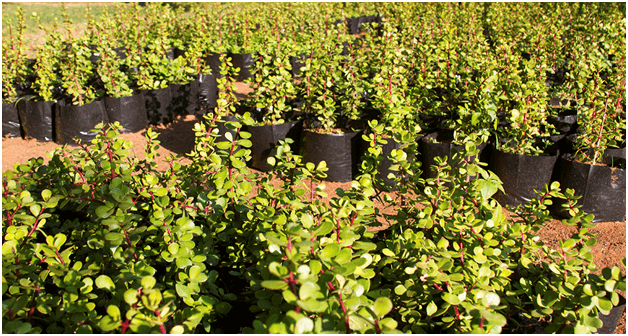
References:
Guralnick L, J. Rorabaugh P, A. & Hanscom Z. (1984). "Seasonal shifts of photosynthesis in Portulacaria afra (L.) Jacq". Plant Physiology. 76 (3): 643–646.
Hall C and Knuth M. (2019). An update of the literature supporting the well-being benefits of plants: A review of the emotional and mental health benefits of plants. Journal of Environmental Horticulture. March; 37(1).
Matthews A. (2020). "How shrubs can help solve climate change". BBC Future. BBC. Retrieved 4 February 2020.
Mills A, J. & Cowling R, M. (2014). "How Fast Can Carbon Be Sequestered When Restoring Degraded Subtropical Thicket?". Restoration Ecology. 22 (5): 571–573.
Paviour S. (2014). Carbon sequestration and trading potential in semi-arid South Africa: A Karoo case study. MSc thesis, University of Stellenbosch, South Africa.
Van der Vyver M. & Cowling R.M. (2019). Aboveground biomass and carbon pool estimate of Portulacaria afra (spekboom)-rich subtropical thicket with species-specific allometric models. Forest Ecology and Management, 448:11–21.
South African Department of Environmental Affairs. Draft Biennial Update Report-3 for the Republic of South Africa to the United Nations Framework Convention on Climate Change (UNFCCC)
State of the Planet – Earth Institute, Columbia University https://blogs.ei.columbia.edu/2018/12/27/35-ways-reduce-carbon-footprint/